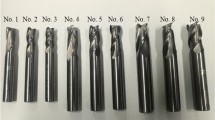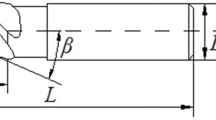Abstract
One major problem in the machining process is the optimization of tool replacement policy and machining condition simultaneously. Although many studies have been developed to optimize the machining process considering the stochastic tool life, they have not optimized these two problems together. Therefore, unlike these investigations, the objective of this study is to develop an integrated mathematical model for joint-optimization of tool replacement policy and machining condition given the dependence between them and various costs in the machining process. In this paper, the dependence of cutting tool life distribution and surface roughness of workpiece to the machining conditions is modeled based on a five-step methodology initially. For this purpose, empirical data of a milling process obtained via design of experiments (DOE) based on Box-Behnken design (BBD) is used. These data, converted by total time on test (TTT), transform and using an optimization process based on golden section search (GSS), the relation between machining conditions and parameters of the tool life distribution is obtained as a full quadratic model. The R2 values for the surface roughness, shape, and scale parameters in the full quadratic models are 89.61, 92.52, and 96.80% respectively, which confirms the adequacy of the proposed methodology. Then, a mathematical optimization model is proposed for multi-pass machining with considering costs related to tool replacement policies, direct labor costs, machining costs, loading/unloading of workpiece costs, and quality costs in a machining process. The proposed model of this study can optimize both of the tool replacement policy and the machining conditions simultaneously and also it can lead to choosing the optimized policy of the continuous or the discrete tool condition monitoring approaches. This model is implemented on a case study and its result is reported. For solving the mathematical model, the electromagnetism-like mechanism algorithm is used that has the proper performance to optimize the continuous spaces.
Similar content being viewed by others
References
Mukherjee I, Ray PK (2006) A review of optimization techniques in metal cutting processes. Comput Ind Eng 50(1):15–34. https://doi.org/10.1016/j.cie.2005.10.001
Davoodi B, Eskandari B (2015) Tool wear mechanisms and multi-response optimization of tool life and volume of material removed in turning of N-155 iron–nickel-base superalloy using RSM. Measurement 68:286–294. https://doi.org/10.1016/j.measurement.2015.03.006
Li C, Xiao Q, Tang Y, Li L (2016) A method integrating Taguchi, RSM and MOPSO to CNC machining parameters optimization for energy saving. J Clean Prod 135:263–275. https://doi.org/10.1016/j.jclepro.2016.06.097
Asiltürk I, Neşeli S, Ince MA (2016) Optimisation of parameters affecting surface roughness of Co28Cr6Mo medical material during CNC lathe machining by using the Taguchi and RSM methods. Measurement 78:120–128. https://doi.org/10.1016/j.measurement.2015.09.052
Kumar R, Chauhan S (2015) Study on surface roughness measurement for turning of al 7075/10/SiCp and Al 7075 hybrid composites by using response surface methodology (RSM) and artificial neural networking (ANN). Measurement 65:166–180. https://doi.org/10.1016/j.measurement.2015.01.003
Shahabi HH, Ratnam MM (2010) Noncontact roughness measurement of turned parts using machine vision. Int J Adv Manuf Technol 46(1–4):275–284. https://doi.org/10.1007/s00170-009-2101-0
Shahabi HH, Ratnam MM (2016) Simulation and measurement of surface roughness via grey scale image of tool in finish turning. Precis Eng 43:146–153. https://doi.org/10.1016/j.precisioneng.2015.07.004
Sen M, Shan HS (2006) Optimal selection of machining conditions in the electrojet drilling process using hybrid NN-DF-GA approach. Mater Manuf Process 21(4):349–356. https://doi.org/10.1080/10426910500411561
Yoon HS, Wu R, Lee TM, Ahn SH (2011) Geometric optimization of micro drills using Taguchi methods and response surface methodology. Int J Precis Eng Manuf 12(5):871–875. https://doi.org/10.1007/s12541-011-0116-6
Guu YH, Deng CS, Hou MTK, Hsu CH, Tseng KS (2012) Optimization of machining parameters for stress concentration in microdrilling of titanium alloy. Mater Manuf Process 27(2):207–213. https://doi.org/10.1080/10426914.2011.566657
Liang YT, Chiou YC (2012) Parametric optimization of micro drilling using machine vision technique combined with Taguchi method. In advanced materials research. Trans Tech Publ 468:2487–2490
Dureja JS, Gupta VK, Sharma VS, Dogra M, Bhatti MS (2016) A review of empirical modeling techniques to optimize machining parameters for hard turning applications. Proc Inst Mech Eng B J Eng Manuf 230(3):389–404. https://doi.org/10.1177/0954405414558731
Kalpakjian S, Schmid S (2006) Manufacturing, engineering and technology SI 6th edition-Serope Kalpakjian and Stephen Schmid: manufacturing. Engineering and Technology, Digit Des. https://doi.org/10.1016/j.whi.2006.08.005
Hui YV, Leung LC, Linn R (2001) Optimal machining conditions with costs of quality and tool maintenance for turning. Int J Prod Res 39(4):647–665. https://doi.org/10.1080/00207540010011063
Xu W, Cao L (2015) Optimal tool replacement with product quality deterioration and random tool failure. Int J Prod Res 53(6):1736–1745. https://doi.org/10.1080/00207543.2014.957878
Wang X, Wang B, Chunmei LV, Chen X, Zhang Y (2017) Research on tool change time and the dynamic reliability of the machining process based on sensitivity analysis. Int J Adv Manuf Technol 89(5–8):1535–1544. https://doi.org/10.1007/s00170-016-9177-0
Vagnorius Z, Rausand M, Sørby K (2010) Determining optimal replacement time for metal cutting tools. Eur J Oper Res 206(2):407–416. https://doi.org/10.1016/j.ejor.2010.03.023
Rodriguez CEP, de Souza GFM (2010) Reliability concepts applied to cutting tool change time. Reliab Eng Syst Saf 95(8):866–873. https://doi.org/10.1016/j.ress.2010.03.005
Pearn WL, Hsu YC (2007) Optimal tool replacement for processes with low fraction defective. Eur J Oper Res 180(3):1116–1129. https://doi.org/10.1016/j.ejor.2006.05.030
Hsu BM, Shu MH (2010) Reliability assessment and replacement for machine tools under wear deterioration. Int J Adv Manuf Technol 48(1–4):355–365. https://doi.org/10.1007/s00170-009-2257-7
Salonitis K, Kolios A (2014) Reliability assessment of cutting tool life based on surrogate approximation methods. Int J Adv Manuf Technol 71(5-8):1197–1208. https://doi.org/10.1007/s00170-013-5560-2
Conrads A, Scheffer M, Mattern H, König M, Thewes M (2017) Assessing maintenance strategies for cutting tool replacements in mechanized tunneling using process simulation. J Simul 11(1):51–61. https://doi.org/10.1057/s41273-016-0046-5
Gupta MK, Sood PK, Sharma VS (2016) Machining parameters optimization of titanium alloy using response surface methodology and particle swarm optimization under minimum-quantity lubrication environment. Mater Manuf Process 31(13):1671–1682. https://doi.org/10.1080/10426914.2015.1117632
Hashmi KH, Zakria G, Raza MB, Khalil S (2016) Optimization of process parameters for high speed machining of Ti-6Al-4V using response surface methodology. Int J Adv Manuf Technol 85(5–8):1847–1856. https://doi.org/10.1007/s00170-015-8057-3
Kant G, Sangwan KS (2014) Prediction and optimization of machining parameters for minimizing power consumption and surface roughness in machining. J Clean Prod 83:151–164. https://doi.org/10.1016/j.jclepro.2014.07.073
Yildiz AR (2013) Cuckoo search algorithm for the selection of optimal machining parameters in milling operations. Int J Adv Manuf Technol 64(1–7):55–61. https://doi.org/10.1007/s00170-012-4013-7
Yildiz AR (2013) Hybrid Taguchi-differential evolution algorithm for optimization of multi-pass turning operations. Appl Soft Comput 13(3):1433–1439. https://doi.org/10.1016/j.asoc.2012.01.012
Ming X, Gao Q, Yan H, Liu J, Liao C (2017) Mathematical modeling and machining parameter optimization for the surface roughness of face gear grinding. Int J Adv Manuf Technol 90(9–12):2453–2460
Tan FP, Creese RC (1995) A generalized multi-pass machining model for machining parameter selection in turning. Int J Prod Res 33(5):1467–1487. https://doi.org/10.1080/00207549508930221
Shukla R, Singh D (2017) Selection of parameters for advanced machining processes using firefly algorithm. Eng Sci Technol Int J 20(1):212–221. https://doi.org/10.1016/j.jestch.2016.06.001
Shukla R, Singh D (2017) Experimentation investigation of abrasive water jet machining parameters using Taguchi and evolutionary optimization techniques. Swarm Evol Comput 32:167–183. https://doi.org/10.1016/j.swevo.2016.07.002
Jiang Z, Zhou F, Zhang H, Wang Y, Sutherland JW (2015) Optimization of machining parameters considering minimum cutting fluid consumption. J Clean Prod 108:183–191. https://doi.org/10.1016/j.jclepro.2015.06.007
Juan H, Yu SF, Lee BY (2003) The optimal cutting-parameter selection of production cost in HSM for SKD61 tool steels. Int J Mach Tools Manuf 43(7):679–686. https://doi.org/10.1016/S0890-6955(03)00038-5
Birbil Şİ, Fang SC (2003) An electromagnetism-like mechanism for global optimization. J Glob Optim 25(3):263–282. https://doi.org/10.1023/A:1022452626305
Koupaei JA, Hosseini SMM, Ghaini FM (2016) A new optimization algorithm based on chaotic maps and golden section search method. Eng Appl Artif Intell 50:201–214. https://doi.org/10.1016/j.engappai.2016.01.034
Standard ISO (1993) 3685. Tool-life Testing with Single Point Turning Tools. https://www.iso.org/standard/9151.html
Rausand M, Arnljot HÃ (2004) System reliability theory: models, statistical methods, and applications, vol. 396. John Wiley & Sons. https://www.wiley.com/enus/System+Reliability+Theory%3A+Models%2C+Statistical+Methods%2C+and+Applications%2C+2nd+Edition-p-9780471471332
Kiefer J (1953) Sequential minimax search for a maximum. Proc Am Math Soc 4(3):502–506. https://doi.org/10.1090/S0002-9939-1953-0055639-3
Dimla DE (2000) Sensor signals for tool-wear monitoring in metal cutting operations—a review of methods. Int J Mach Tools Manuf 40(8):1073–1098. https://doi.org/10.1016/S0890-6955(99)00122-4
Song S, Coit DW, Feng Q, Peng H (2014) Reliability analysis for multi-component systems subject to multiple dependent competing failure processes. IEEE Trans Reliab 63(1):331–345. https://doi.org/10.1109/TR.2014.2299693
Song S, Coit DW, Feng Q (2014) Reliability for systems of degrading components with distinct component shock sets. Reliab Eng Syst Saf 132:115–124. https://doi.org/10.1016/j.ress.2014.06.020
Budak E, Tekeli A (2005) Maximizing chatter free material removal rate in milling through optimal selection of axial and radial depth of cut pairs. CIRP Ann Manuf Technol 54(1):353–356. https://doi.org/10.1016/S0007-8506(07)60121-8
Taguchi G, Elsayed EA, Hsiang TC (1989) Quality engineering in production systems, vol 173. McGraw-Hill, New York
Brito TG, Paiva AP, Ferreira JR, Gomes JHF, Balestrassi PP (2014) A normal boundary intersection approach to multi response robust optimization of the surface roughness in end milling process with combined arrays. Precis Eng 38(3):628–638. https://doi.org/10.1016/j.precisioneng.2014.02.013
Kumar NS, Shetty A, Shetty A, Ananth K, Shetty H (2012) Effect of spindle speed and feed rate on surface roughness of carbon steels in CNC turning. Proced Eng 38:691–697. https://doi.org/10.1016/j.proeng.2012.06.087
Author information
Authors and Affiliations
Corresponding author
Rights and permissions
About this article
Cite this article
Zaretalab, A., Haghighi, H.S., Mansour, S. et al. A mathematical model for the joint optimization of machining conditions and tool replacement policy with stochastic tool life in the milling process. Int J Adv Manuf Technol 96, 2319–2339 (2018). https://doi.org/10.1007/s00170-018-1683-9
Received:
Accepted:
Published:
Issue Date:
DOI: https://doi.org/10.1007/s00170-018-1683-9




